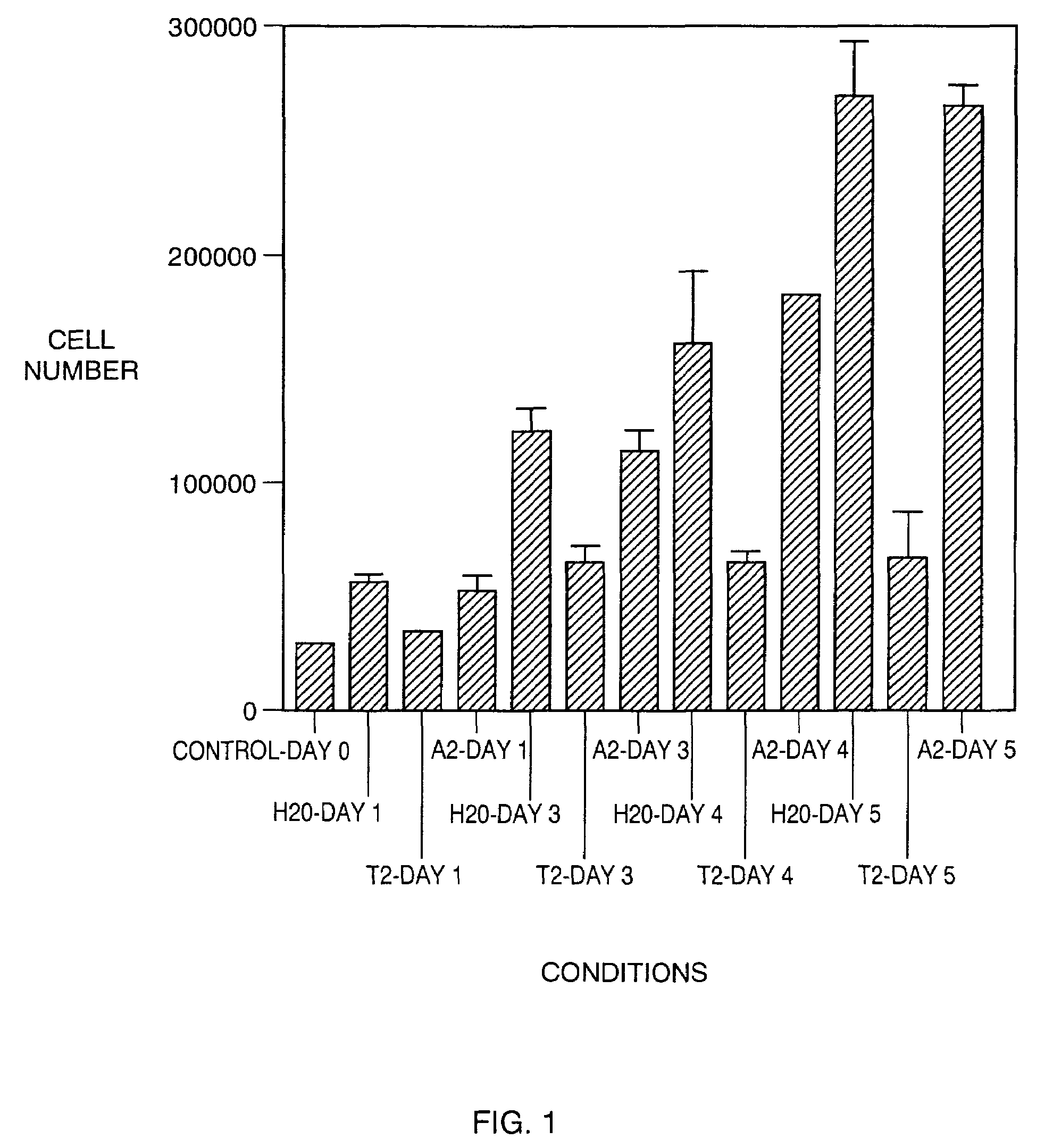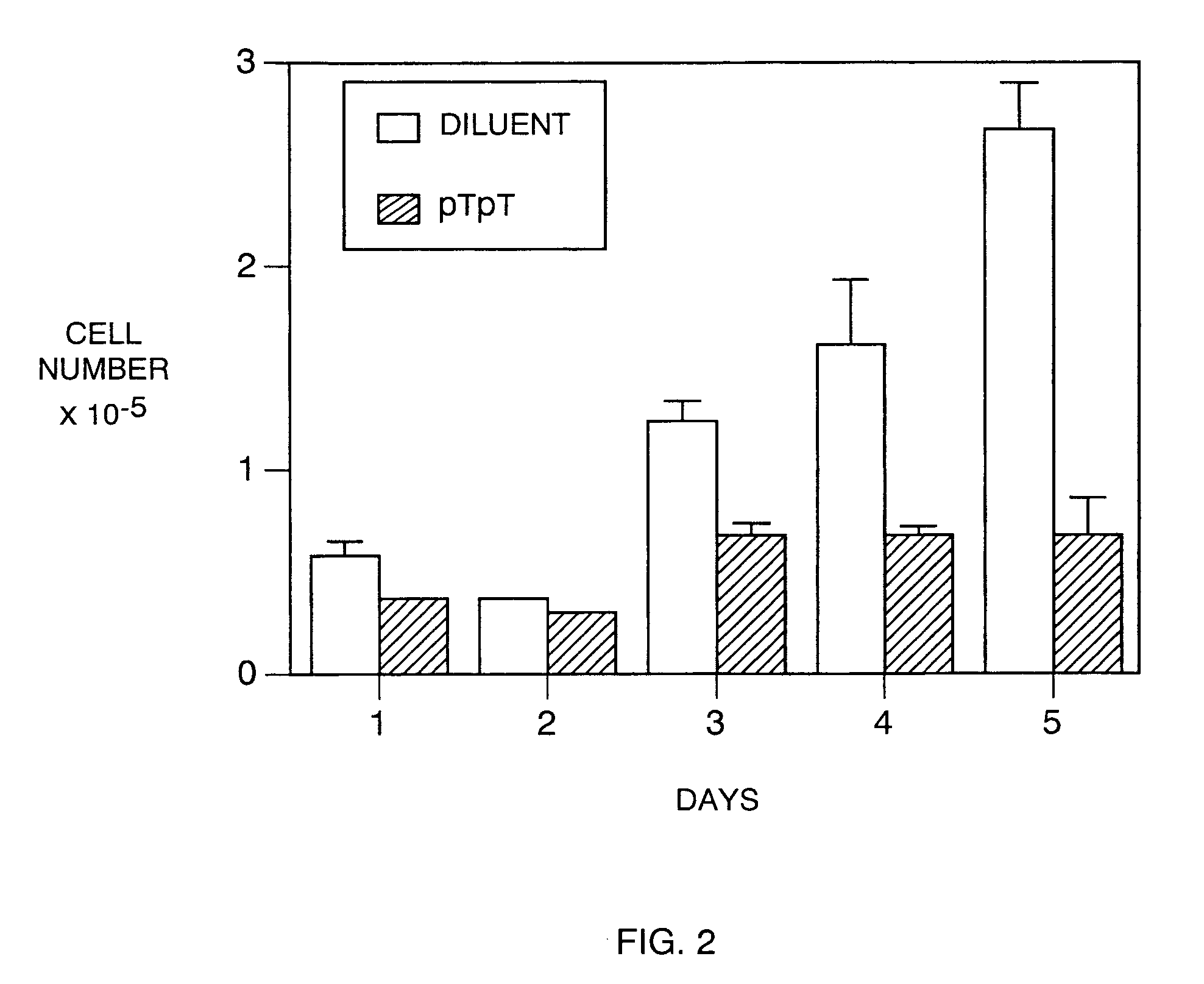Use of locally applied DNA fragments
a technology of dna fragments and local application, which is applied in the field of local application of dna fragments, can solve the problem of the same risks of treatmen
- Summary
- Abstract
- Description
- Claims
- Application Information
AI Technical Summary
Benefits of technology
Problems solved by technology
Method used
Image
Examples
example 1
Application to Human Squamous Carcinoma Cells
[0061]Human squamous carcinoma cells line SCC12F cells were maintained in primary keratinocyte medium (300 ml DME, 100 ml F-12 nutrient supplement, 50 ml 10× Adenine, 50 ml fetal bovine serum, 5 ml penicillin / streptomycin stock, and 0.5 ml of 10 μg / ml epidermal growth factor and hydrocortisone to final concentration of 1.4 μg / ml) and dosed with either water (diluent), 100 μM pTpT (T2, Midland Certified Reagent Company, Midland, Tex.) or 100 μM pdApdA (A2). Cells were harvested before dosing (day 0), and 1,3,4, and 5 days after dosage, and were counted by COULTER™ counter. After harvesting, the cells were processed for total RNA isolation and were analyzed by Northern blot. Addition of pTpT to human squamous carcinoma cells resulted in marked decreases in cell growth rate, as shown in FIG. 1. Addition of a control deoxyadenine dinucleotide (pdApdA), a compound very similar to pTpT but not readily dimerized by UV irradiation and therefore r...
example 2
Application to Human Cervical Carcinoma Cells
[0066]Human cervical carcinoma cells (HeLa cells) were maintained in DME+10% calf serum and dosed with either water (diluent) or 100 μM T2. Cells were collected 1, 4 and 6 days after dosage and counted by COULTER™ counter.
[0067]Addition of T2 to the human cervical carcinoma cells resulted in marked decreases in cell growth rate, as shown in FIG. 3.
example 3
Application to Human Melanoma Cells
[0068]Human melanoma cell lines CRL 1424, Malma, Sk Mel 2, and Sk Mel 28 were obtained from the Collection AMERICAN TYPE CULTURE COLLECTION (ATCC). The cell lines were maintained in DME+2% calf serum, and dosed with either water (diluent) with DME, or 100 μM T2 in DME. One week after dosage, cells were collected and counted by COULTER™ counter.
[0069]Addition of T2 to any of the four different human melanoma cell lines results in marked decreases in cell yields, as shown in FIG. 4.
PUM
| Property | Measurement | Unit |
|---|---|---|
| concentration | aaaaa | aaaaa |
| concentration | aaaaa | aaaaa |
| pH | aaaaa | aaaaa |
Abstract
Description
Claims
Application Information
 Login to View More
Login to View More - R&D
- Intellectual Property
- Life Sciences
- Materials
- Tech Scout
- Unparalleled Data Quality
- Higher Quality Content
- 60% Fewer Hallucinations
Browse by: Latest US Patents, China's latest patents, Technical Efficacy Thesaurus, Application Domain, Technology Topic, Popular Technical Reports.
© 2025 PatSnap. All rights reserved.Legal|Privacy policy|Modern Slavery Act Transparency Statement|Sitemap|About US| Contact US: help@patsnap.com



